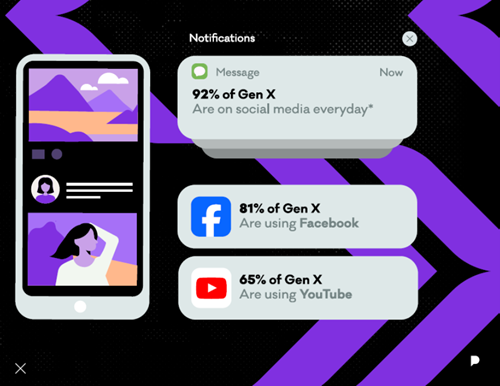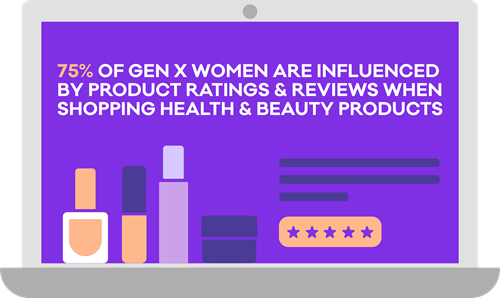
Gen X are a generation at the peak of their spending power, outspending both younger and older Health & Beauty consumers by up to 44%. But despite this, they’re often overlooked & ignored by brands, something that is even more true in the digital space.
This means there is a huge opportunity for those brands who are able to engage these consumers. So, how can health & beauty brands win with these consumers online? Let's start by understanding a little bit more about those spending habits...
Mo’ Money Mo’ Less Problems?
Our 40s and 50s are when our disposable income is at its peak. In fact, 94% of Gen Xers still have money left once their bills are paid. And what are they spending that cash on? Well, Gen X spend more on hair and skin care than both Millennials and Gen Z, dropping an estimated £8BN annually on health and beauty products
So, with more money and a greater propensity to spend it, you’d think advertisers and marketers would be falling over themselves to reach, engage and convert our Gen Xers, right? Wrong! In fact, less than 5% of marketing strategies in the US target women over 50. As you’ll see this, means they represent a hugely lucrative opportunity for brands.
In this blog, we examine the behaviours and attitudes of this generation and explore the most effective ways for brands to engage, win and retain the loyalty of these consumers.
The Invisible Generation?
Often described as the ‘middle child’ between Boomers and Millennials, it is this overlooking and complacency toward Gen X that has led to them being described as the forgotten or invisible generation.
So, how can your brand make sure it is ready to engage, win and retain the loyalty of Gen X online?
To answer that, let’s begin with a dive into some of their behaviours and habits, starting with a quick reminder of who they are.
Currently, Gen Xers are aged between 44-59. In the UK, they make up around 14M consumers – that’s roughly 20% of the population.
Online Behaviour:

It can be easy to think of Gen X as ‘digital dinosaurs’ but let’s remember, this generation came up with technology. So how do they behave online?
According to Wavemaker, 92% of Gen X are on social media every day. Their platforms of choice? Well, 81% are using Facebook, followed by 65% on YouTube. While Gen X is the fastest growing user group on both Instagram and TikTok.
The main drivers for their social media usage are a desire for connections and nostalgia. Gen X have moved real-life relationships online, whether it’s family, parents, colleagues or, increasingly with the likes of WhatsApp and Facebook Groups, local communities or interest groups. Social is where they come together to connect, be entertained, to buy and to sell.
As for nostalgia? We know it’s a powerful drug for all generations, but social media plays an important role for Gen X as a way for them to outsource their memories.
And here’s the really good news – unlike other generations, Gen X are more likely to follow a brand (75%) than say, a celebrity (72%) on social media. In fact, Gen X understand social platforms are a really useful tool when it comes to discovering brands or products.
Online Product Discovery:
You might assume Gen X would feel more comfortable going in store to shop. But that’s a major misconception. No, for this time-starved cohort, the ease and convenience to discover, research and order products online at the touch of a button is super-appealing, even more so than for younger consumers.
What’s driving this? Mobile, bite-size friendly online discover is key, with over half of all Gen Xers saying they look online for health and beauty inspiration, compared to 9% saying TV and 7% magazines.
Gen X recognises the power of social platforms to discover brands. It’s changed the way they shop and many of them applauded the fact that it’s allowed them to discover brands they would never have found otherwise.
That said, they’re less promiscuous than younger consumers when it comes to what they buy, considering 27% fewer brands than younger audiences and their purchases tend to be more driven by need.
Because they’re less likely to buy on a whim, social media alone is unlikely to drive purchase. It’s one of several steps in their buying journey: when exposed to a brand on social, many of them go to other places to validate - this includes reviews, checking with their network, seeking out the brand in more trusted offline touchpoints like TV or other retail touchpoints. So, brands must think omnichannel.
How to Engage, Win and Retain the Loyalty of Gen X Online
We know they want to discover, research and, armed with the right knowledge and level of trust, purchase online. How can we make sure we help that happen, from reaching them on the platforms they’re most active, to serving them the kind of content they want to see, while engaging and talking to them in ways they’ll be most responsive to?
What do they want to see?

Like most generations today, Gen X favour video. This doesn’t mean there isn’t a role for imagery to play, of course, but the rise of TikTok, Reels and YouTube Shorts has seen social algorithms give these and other video formats even greater prominence which, when combined with Gen X’s preference for video content, means video must be at the centre of your digital output.
Put simply, you’ll need to be pushing out A LOT of video content. As we’ll dive into later, this needn’t mean it’s all created by you and your brand. But first, let’s look at what should be in those videos.
What Type of Video Content?
Starting with YouTube, 43% of Gen X women say this platform is where they go to be educated or inspired. With 25% stating they look to videos for Health & beauty inspiration, while 20% say they look for videos that provide education & tutorials around specific products or brands.
So, educational content is one area to focus your efforts, producing video content that informs and educates, be it product ingredients, regime tips or application/usage instructions.
And what else? Well, as far as your Gen X audience is concerned, keep it real – they want authenticity, relatability and representation above all. 85% say authenticity is important when deciding what brands they like and support. And, when asked what would influence them to buy a new health & beauty product, 42% of Gen X women told us they wanted to see people of their age/life stage in advertising and other communications. We already know that Gen X and older are under-represented in advertising (just 24% of TV ads feature people over 50), and 79% of users aged 55+ told us they don’t see themselves reflected in ads.
The message is clear, when it comes to content, users want to see themselves reflected back. It’s crucial your brand and content doesn’t go chasing or showcasing an overly idealistic view of who they think their customers are.
So, if you’re targeting Gen X, ensure you’re using women of similar ages and life-stages within your content, from social media posts and photoshoots, through to the influencers and ambassadors you choose to work with.
Stay positive!

And keep it positive! We’ve heard from consumers how brands targeting women in their 40s and 50s can inadvertently make them feel older than they are, e.g. grey hair or focussing on the negative aspects of aging. These women want to be reminded that life didn’t stop when they hit 40, and there are plenty of active, inspiring women in this age group, so focus on the positives! Which leads us on to messaging.
Remember – Gen X want to feel seen and they want to feel heard. So again, in the name of authenticity, don’t feel you need to shy away from talking about the big issues. Menopause, elderly parents, health issues, kids leaving home – this life stage can be challenging, and by talking about these issues head on, you’re letting Gen X know they’re not alone, fostering a sense of community. It’s a theme we’ll come back to, but make them ‘feel seen’, with an acceptance, discussion and ideally, a solution, to their problems.
To that end, root any content in highly relatable, real-world scenarios that Gen Xers can relate too.
No Bullsh*t
Another big tip when it comes to messaging targeted at Gen X? No BS! While (perhaps surprisingly) Gen X are less cynical about new products and innovations than Gen Z and Millennials (two thirds are happy to believe that innovation can lead to better products), they’re also information led.
Don’t think you can just dazzle them with a new ingredient – there’s little appetite for made up, pseudo-scientific terms or ingredients. Gen X want to know, in the simplest terms, what’s in it for them? So, if you have great a new product innovation or technology, showcasing proper data and explaining how the products or ingredients work and will deliver results can go a long way in creating credibility and product interest. And this more cynical stance also means Gen X have less tolerance for overly salesy or hyperbolic content, especially from influencers.
Lastly, when it comes to messaging, remember this: Gen X are savvy shoppers who value financial security: this is a generation who may be preparing to send kids to college or dealing with aging parents who need care, so despite their disposable income, discounts and added value will resonate strongly. Gen X are looking for deals as well as long-term financial health.
Under The Influence: Influencers, User Generated Content & Reviews
Friends, family and professionals are still Gen X’s most trusted sources for Health & Beauty product recommendations, but they’re increasingly turning to influencers. Now, while Gen X still have reservations around both influencers and celebs - lack of expertise, perceived impartiality or fake authenticity all undermine their credibility in the eyes of Gen X - according to our research, 1 in 5 Gen X women can still be persuaded by an influencer (up from just 7% in 2020). In short, they’re still an integral part of any Gen X-focussed digital strategy.
With that said, how can you address the concerns mentioned and still run an effective influencer campaign?
Well, again, authenticity, relatability and perceived ‘realness’ are all key. Gen X are more likely to engage and respond significantly more positively to content which features creators of their own age and who are representative of them, with content that features relatable scenarios or similar challenges to those faced by Gen X.
Make sure you’re working with creators who reflect this audience’s everyday life, rather than turning them off by using creators living lavish lifestyles in unattainable settings.
To that end, there’s a scepticism and distrust of some celebrities and large influencers. Their size can bring eyeballs to a brand, but with that reach comes a perceived lack of authenticity once again. Consider the follower size of your would-be influencers carefully.
The need to take a longer-term approach
So, you know you need to work with smaller influencers ideally, and they need to be of a similar age to your Gen X audience, while being mindful to create content that is grounded, relatable and attainable? Great. But, it’s not enough to do that once!
Rather than jumping from creator to creator, campaign to campaign, take a longer term approach and build lasting relationships with your brand ambassadors. Unlike short, one-off, buzz-building pieces of content which can be effective among younger audiences, creators need to earn the trust of Gen X and establish credibility through ongoing activity.
The Importance of UGC
The issue of trust leads as onto User Generated Content (UGC) and the importance of real stories from real users.
When it comes to buying online, people are still wary. Especially our Gen X audience who’s financial savviness we’ve already established. People rely on information from other shoppers to help them feel confident enough to purchase. The more detailed and reliable that information is, the better.
That’s where UGC comes in:
- 92% of consumers trust recommendations from real people over traditional advertising
- 86% of consumers prioritize authenticity when choosing beauty products.
- 61% of beauty consumers prefer engaging with UGC over traditional brand content
- UGC empowers customers to become active participants in a like-minded community
And, while 50% of shoppers say they’d like to see a mix of UGC and professional photography when buying, if they had to make a choice, they state they’d pick UGC.
Why? It’s more authentic, more reliable, more trustworthy.
And this tallies with what we’re seeing across social media. As we mentioned when speaking about representation and relatability earlier, people want to see themselves reflected back, and UGC does this in a way that branded content and creator-made content can’t.
The Reviews Are In!

While UGC will live primarily on your socials, when it comes to showcasing real users and their experience with your brand, we also need to talk about reviews. Reviews are a powerful tool when it comes to validating Gen X’s interest in a brand or product. 75% of of Gen X women are influenced by product ratings or reviews when purchasing health & beauty products
Why? Validation! We know Gen X want to get straight to the point – which products work, why and how should they use them. Reviews cut through the noise and get to those facts: does the product work? What problem has it solved? And because it comes from a real user rather than the brand or an influencer, there is no ulterior motive present. Even better if the reviews include images or videos from users.
So, now’s the time to revisit your review strategy: Are you actively soliciting these? How often? And how long after purchase? If you’re not seeing volume, consider adjusting the timing of when you ask for a review, or incentivising with an offer or discount
Also, make sure you have a sampling programme in place, ensuring you’re getting product into the hands of real people to review on a regular basis. Not only does this drive genuine reviews in bulk, but it can also yield a good haul of useable UGC too.
Reviews are a great way to temper Gen X’s natural scepticism, allowing them to view your brand as more trustworthy. And trust is a key point for this audience when we think of how they engage online.
Trust Me
According to Wavemaker, ‘trust’ is 30% more important to Gen X’s buying decisions than it is for younger generations. And while established brands can leverage social and use this to their advantage, it can be a lot harder for newer brands to build trust among consumers, with brands on social seen as untrustworthy until proven otherwise.
With the rise of things like TikTok shop, buyers can make a purchase at the tap of a button, but Gen X need reassurance before they take this leap.
Reviews, UGC and less aspirational, more ‘real’ content are all useful weapons on this quest to trustworthiness, while little bits of housekeeping on social such as ensuring your returns policy is clearly signposted (or even pinned as a Story highlight) can all help to establish trust and reassure your audience.
What’s the takeaway?
All of this should have left you with a good understanding of who Gen X are and how you can best engage them online, whether that’s the things they want to see, the words they want to read, or the different ways in which your content can help usher move them along their purchase journey.
Ultimately, the way to win over Gen X is with honest, genuine content that reflects their lived experiences. The reward for authentically connecting with this overlooked generation is a potential lifetime of brand loyalty.
- Be Authentic And Keep It Real: But that doesn’t mean be boring! Gen X want content, products and brands they can relate to. So keep this in mind when producing content. Make it relatable not just to their life-stage and needs, but their day-to-day as well, whether it’s making light of the numerous menopause symptoms, jumping on relevant trends or ensuring a good flow of UGC, make sure you’re being as authentic and true to your Gen X consumers as possible.
- Straight Talking: Gen X take won’t stand for bs. They’re sceptical, they’re time poor and they’ve been there, done that. So give them the facts, communicate clearly and get to the point.
- Establish Trust: We’ve said they don’t want any nonsense. By the same token, they want to see products that work. So product reviews, UGC and real stories from real customers are all vital at building trust and loyalty among this audience. Make sure you’ve got product reviews enabled on your product pages, encourage and incentivise that flow of user generated content and think carefully about the creators you chose to work with – their size and their credibility are key.
Posted 3 May 2024 by Ben Waterhouse